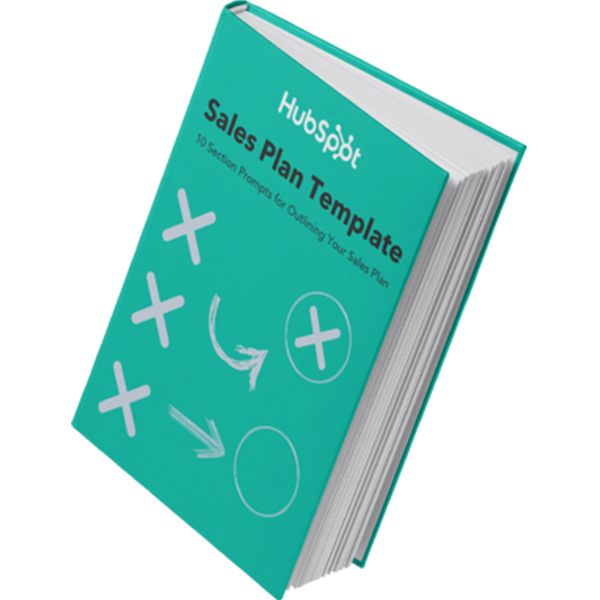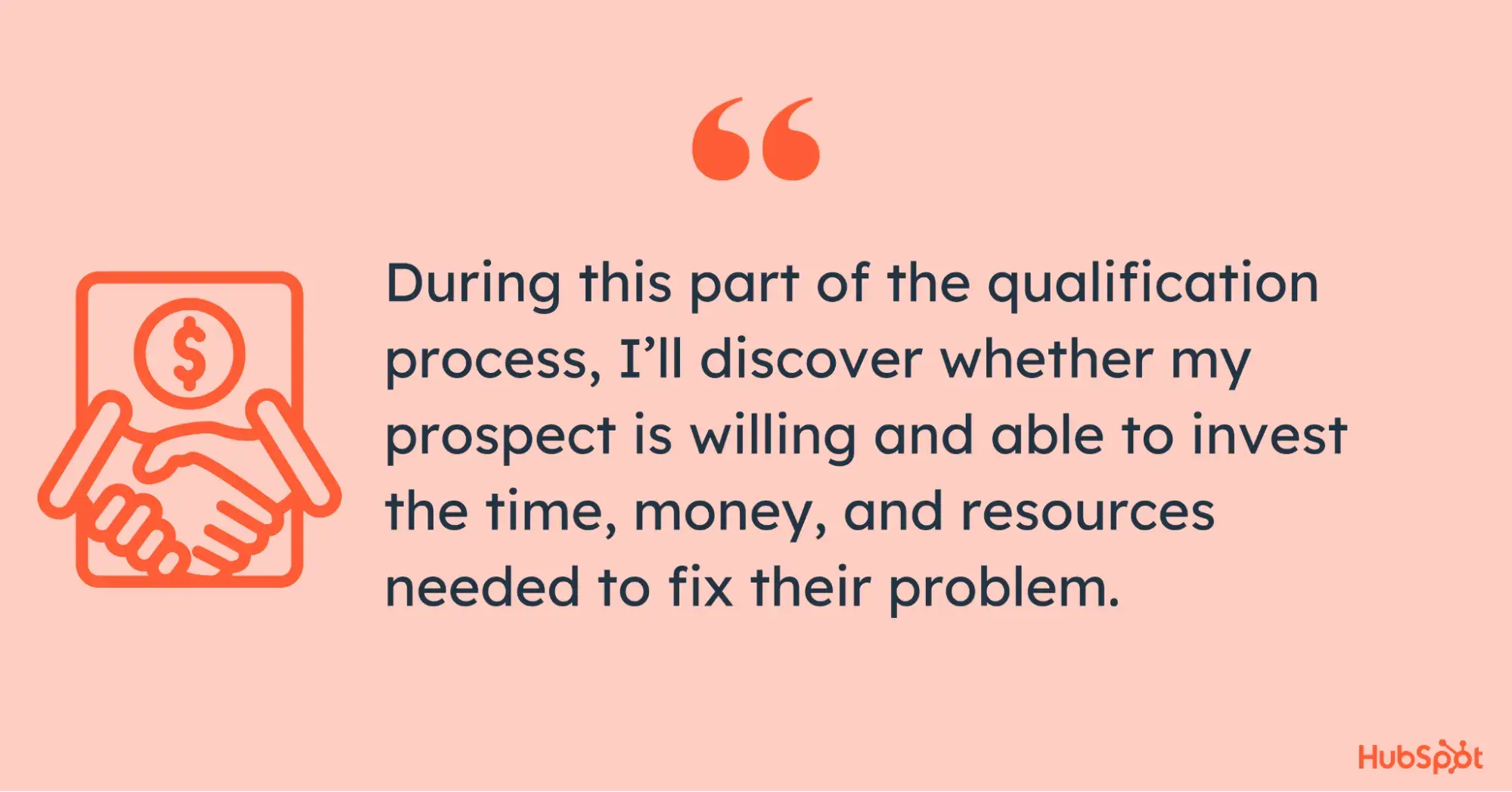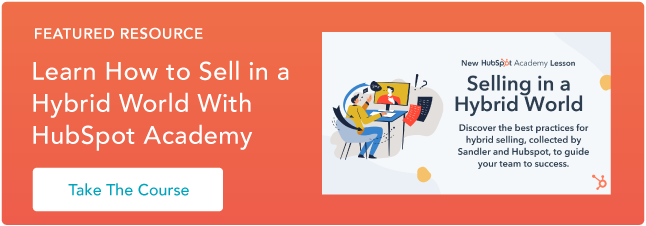I’ll be honest: Selling doesn’t always come naturally to me, even though I’m a professional marketer.

But with the Sandler Selling System, I don’t have to go it alone. This popular sales approach was introduced over 50 years ago, and it’s been a staple ever since.
To help you understand what the Sandler System is about, I spoke to the organization’s former VP of sales technology practice, Rebecca Schmidt, about how the system is organized and how to use it in my own sales process.
Table of Contents:
- What is the Sandler Selling System?
- Steps of the Sandler Selling System
- How to Incorporate the Sandler Selling System
What is the Sandler Selling System?
The Sandler Selling System is a seven-step process where a sales rep acts as an advisor to the potential buyer, asking questions until both sides are convinced the product is a great fit. This relieves pressure for prospects and sales professionals, compared to an atmosphere where the salesperson persuades the buyer to purchase something regardless of their situation.
The Sandler Sales Submarine
If you’re more of a visual person, the Sandler System has tons of great templates to help you imagine the process. Perhaps the most notable is the submarine concept, which David Sandler conceived while developing his selling system.
According to the company lore, Sandler was inspired while watching WWII movies. "When submarines were attacked, to avoid flooding, the crew moved through each compartment, closing the door of the previous compartment behind them. The Sandler Selling System requires the same procedure to avoid ‘disaster' on a sales call."

Free Sales Plan Template
Outline your company's sales strategy in one simple, coherent sales plan.
-
Target Market
-
Prospecting Strategy
-
Budget
-
Goals
Ioanna Mantzouridou Onasi, CEO of the AI coaching firm Dextego, has benefited from using the selling system.
Onasi says the Sandler Selling System “ensures I don’t skip essential stages in the sales process, particularly when dealing with complex sales. By visualizing each step as a compartment that needs to be sealed off before moving to the next, I can manage the sales process more effectively.”

You can see how the submarine visualization really helps understand the process of the selling system, and how to use it effectively. We’ll explore each step in detail below.
Biggest Perks of the Sandler Process
At times, the Sandler sales process reminds me of a traditional sales system, but its emphasis on the qualifying stage — rather than the closing stage — makes a big difference in how my sales team closes deals. According to HubSpot’s 2024 State of Sales Report, 58% of sales reps said “deals for best-fit customers” is one of their most effective sales techniques.
Emma Brudner, a former marketing director at HubSpot, says, "If the rep discovers that their offering won‘t truly address the potential client’s concerns, they won‘t waste time convincing them that it actually does — they’ll simply abandon the process. Rather than the seller convincing the buyer to buy, the buyer almost convinces the seller to sell."
When implemented effectively, the Sandler process helps me beef up my average sales price (ASP). In HubSpot’s 2024 State of Sales Report, nearly 1,500 sales reps said that 47% of their deals were between $1,000 and $5,000. If you’re not quite there, or you want your average to grow more, this is a good selling methodology for you.

Overall, I use the Sandler system to increase my margins, decrease the length of my sales process, and improve forecast accuracy with a cleaner sales pipeline overall.
When speaking with Rebecca Schmidt, Sandler’s former VP of sales technology practice, she told me the reason she believes the Sandler techniques are so effective.
Schmidt says that it’s because the techniques are “fully grounded in a real psychological discipline that focuses on how people truly communicate. It tends to really take root in an organization when leadership is passionate about improving the performance of their team (sales, pre-sales, customer success), and leads by example."

Schmidt adds, "When we start an engagement and leadership is energized about the process ... we know the team will see results. These leaders will use Sandler to create a culture that embraces improvement at all levels of the organization."
Are you curious and excited? Let’s dive into each part of the selling process.
Steps of the Sandler Selling System
- Bonding and building rapport.
- Upfront contracts.
- Pain.
- Budget.
- Decision.
- Fulfillment.
- Post-sell.
The Sandler Selling System has three overall stages — engaging, qualifying, and closing — which are further broken down into seven steps:
1. Bonding and Building Rapport
The first step in the engaging stage is relationship building, which is establishing a bond with your prospect. I’ve found this encourages open and honest communication, which is essential for sales. My peers agree: 26% of the sales reps said establishing trust and building rapport are more crucial in 2023 compared to 2022.
If I don’t establish a relationship, prospects simply have fewer reasons to say yes.
2. Upfront Contracts
The second step is to set roles and expectations. During this phase, I communicate ground rules and create a comfortable environment in which to do business.
In my experience, this is a good time to show you’ll be answering questions the prospect has and serving as their point of contact. I make that clear from the beginning because I don’t want them to feel confused or pressured.
3. Pain
We then move into the second stage of the system: the qualification phase. Now that I’ve built rapport and set expectations for how the sales process will play out, I dive in and uncover my prospect’s pain points. In other words, the reasons my product or service will help this person. Honestly, this is probably the stage I struggled with the most because I’d rather not intrude.
Schmidt reassured me it’s a challenging phase, as “sales reps often struggle with moving beyond the prospect’s first-level pain — because it can be uncomfortable to ask second-level pain questions (How have you tried to solve this? How much has not fixing the issue cost you?) and third-level pain questions (How is this impacting you professionally and personally?).”

Free Sales Plan Template
Outline your company's sales strategy in one simple, coherent sales plan.
-
Target Market
-
Prospecting Strategy
-
Budget
-
Goals
Fortunately, Schmidt also had a solution to my apprehensions with the qualifying phase. “At Sandler, we work with reps to uncover the self-limiting belief(s) they may have about executing any technique. And then we work to establish a positive belief — and behavior to support the new belief,” she advises.
For example, let’s say my rep feels they're being too pushy and intrusive by asking those second and third-level pain questions. After all, I know I feel kind of strange asking someone how their CRM software has impacted their personal life.
Schmidt says that I should reframe that fear of intruding as a positive belief, like this: Asking second and third-level pain questions proves I want to understand the prospect’s whole situation because I’m working toward their success.
Next, I have to implement a behavior to support that belief. Personally, after interacting with the prospect, I write a quick email to my boss, letting them know how it went. Just knowing I’m going to be checking in afterward tends to boost my confidence a bit. Eventually, you’ll find a habit that works for you.
4. Budget
A traditional sales conversation has budget talk scheduled toward the end of the process, but in the Sandler Selling System, you'll discuss your prospect’s budget during the qualification phase.
I know it sounds uncomfortable to talk money upfront, but it has proved worth it. After all, if my prospect can‘t afford my product, there’s no point trying to sell it to them. Keep in mind that 70% of the reps we surveyed felt budgets were more scrutinized in 2023 than they were in 2022, so going over the cost specifics is a must.
During this part of the qualification process, I’ll discover whether my prospect is willing and able to invest the time, money, and resources needed to fix their problem.

5. Decision
The last part of the qualifying phase is to discuss the decision-making process. By this point, all of the decision-makers should be identified (and hopefully involved).
At this stage, I find out the who, what, where, why, and how of my prospect’s preferred buying process. Importantly, I hammer out the small details of what the buyer is looking for.
Pro tip: 23% of the sales reps we questioned said selling directly to the most senior decision-maker was one of their most effective sales strategies.
6. Fulfillment
Moving on to the closing stage of the process: this is when I propose my product or service as the solution to my prospect's problem. My proposal should comprehensively fulfill their requests, especially regarding the budget and the decision-making process.
In your fulfillment proposal, remember to use everything you've learned during the qualifying process.
We’ve found the average close rate hovers around 29%, so while it might seem impossible at times, I’ve done most of the work by this point, and my odds are looking good!
7. Post-Sell
Finally, it‘s time to seal the deal. I establish the next steps of my post-sale and try to prevent any buyer’s remorse or losing out to competitors.
I’d also recommend setting your new client up with any learning material they might need; if it would help, walk them through a few tutorials.
Example Questions for Each Stage of Sandler Selling
Here are a few example questions you can try for each of the seven stages.
1. Rapport. Thanks for meeting with me today. Is there anything new I should know about since we last spoke?2. Upfront contracts. I’d like to make sure we know who we’ll be interacting with. May I explain a little about my organization? Next, you could do the same for yours.
3. Pain. What’s the biggest issue you hope we can help you with? What would your ideal solution look like?
4. Budget. Have you thought about what your budget for this solution will look like? If you think about it like booking a hotel, are we looking at a three-, four-, or five-star hotel for this issue?
5. Decision. So, who’s usually involved in decisions like these? Are they already hands-on in our case?
6. Fulfillment. If I said we could fix all of your problems except this one, would it be an issue? Is there any way I could still make this work?
7. Post-sell. What do you imagine are the biggest roadblocks to onboarding with us?
Now that you’re familiar with each step of the Sandler Selling System, you’re probably envisioning implementing them at your business. Next I’ll explain how to train your sales reps using the Sandler system.

Free Sales Plan Template
Outline your company's sales strategy in one simple, coherent sales plan.
-
Target Market
-
Prospecting Strategy
-
Budget
-
Goals
How to Incorporate the Sandler Selling System
I find it challenging to implement any new training into my team's existing processes, but there are certain techniques that make it easier.
Sandler Training Courses
When you’re ready to get started, you can take Sandler sales certification courses online. I really like all the different formats the company offers: I can listen to podcasts on my way to work or read an article during my lunch break. There are even in-person courses.
Next, let's look at the insider tips I got from Schmidt on implementing the Sandler system effectively and getting the most out of it.
Sandler Pro Tips from the Former VP
Schmidt told me organizations that are successful with the Sandler Selling System first look at their existing sales process and "work to identify which pieces of Sandler fit within each sales stage and which pieces can be used throughout — making it easy for the rep and managers to see how Sandler helps them execute more effectively.”
Let’s say I’m trying to incorporate Sandler’s upfront philosophy into every sales stage. I might start by requiring my sales leaders to ask their reps, “What does your upfront contract sound like for your next call?”
For individual stages like the Pain Funnel, I can reinforce some of the same questions in other stages. For example, during the discovery or qualifying stages, my boss might say to me, “You asked the prospect how much they lost by not fixing the issue. How did they respond?”
These questions are both open and closed-ended, so you’ll have some easy answers (e.g., it cost them $25,000 per year) and some that are harder to quantify (e.g., they suspect it might have lost them an employee or two).
Each organization‘s sales process looks different, so I recommend doing trials until you find what works best for your unique team’s collaborative style.
To properly teach the Sandler system, it's vital to master it first. As Schmidt tells me, “The biggest roadblock managers and leaders face is trying to reinforce concepts they do not fully understand themselves.”
To prevent this from happening in her workforce, "the managers are always present (and actively engaged) in our rep training. We have separate manager-focused sessions teaching them how to reinforce Sandler throughout their sales process,” she adds.
We all know that change isn't easy, but the more my leadership incorporates the Sandler Selling System into existing processes, the easier it is for reps to get on board. For a more in-depth look at accomplishing this, take a look at this video:
Getting the Most from the Sandler System
The Sandler Selling System isn‘t the only sales model around, but it’s one of the best for thoroughly qualifying your prospects so you sell to the right people.
Sandler helped HubSpot grow our average selling price by 12% and reduce our sales cycle by 18%. This sales success boils down to similar values and mutual trust between the two companies. If you’re looking to nuture your clients and offer support, a partnership with HubSpot and Sandler could be just the thing.
Editor's note: This post was originally published in October 2021 and has been updated for comprehensiveness.
![Learn How to Sell in a Hybrid World With HubSpot Academy [Free Lesson]](https://no-cache.hubspot.com/cta/default/53/00de7d2c-57b4-462e-ac69-bbe8131cffc9.png)




![What is Enterprise Sales? [+ How It Differs From SMB and Mid-market Sales]](https://blog.hubspot.com/hubfs/Sales%20Enterprise.png)





